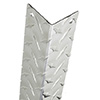Stainless Steel
Click below for pertinent facts and informational links for the materials that our corner guards are made from.
Our stainless steel corner guards are made from Type 304 or Type 316L stainless steel. We use 7 - 22 gauge depending upon your needs. We offer finishes in a #4 - Brushed, #8 - Polished Mirror or #2 Dull.
Stainless Steel Stainless Steel is used across a wide range of applications and this has led to the development of a wide range of stainless steels. There are 4 main groups of stainless steel - Austentic, Ferritic, Martensitic and Duplex stainless steels. Austentic stainless steels are the most important and widely used group of stainless steels and grades AISI 304 (EN 1.4301) and AISI 316 (EN 1.4401) and AISI 316L (EN 1.4404) stainless steel are the most common. The stainless steels used by ATN Stainless Steel are ideal for applications in the food processing, brewing, pharmaceutical and chemical industries. They provide a high resistance to corrosion attack and are readily formed and fabricated. Grade 304 stainless steels contain around 0.8% chromium and 8% nickel and provides excellent corrosion resistance. Grade 316 & 316L are used in corrosive environments such as pool areas (chlorides), where chemicals will come in contact with the material and for marine applications. 316 grade stainless steels contain 18% chromium, 10% nickel and 3% molybdenum. Unlike all other grades of stainless steels, austenitic grades are non-magnetic.
- Excellent resistance in highly aggressive corrosive environments
- Hygienic and clean ability surfaces
- Aesthetically attractive surface finishes from 2B to a mirror polish. The finish on your refrigerator is typically called a 'Brushed Finish' or also a '#4 Finish'.
- Good forming and fabrication characteristics
- Good resistance to wear and abrasion












